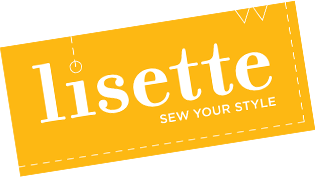For those of you who haven’t been following the chatter in the Lisette discussion forums, the new Lisette fabrics have begun arriving on shelves at Jo-Ann stores across the United States.
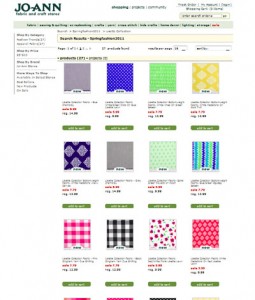 We’ve been excited to hear your reaction to seeing them in your local stores, and we hope to hear from more of you as they make their way into the remaining Jo-Ann stores across the country.
We’ve been excited to hear your reaction to seeing them in your local stores, and we hope to hear from more of you as they make their way into the remaining Jo-Ann stores across the country.
Now, for those of you who prefer to do your shopping on-line, we’ve got some good news.
For a limited time at the Jo-Ann website, you’ll save 40% on all the new Lisette fabrics.
Choose from our chambrays, lawns, twills, poplins, sateens, and more. And at 40% off, there’s no reason not to start restocking your stash. Right?
Unfortunately, at this time Jo-Ann only ships to United States addresses. Sorry to those of you who live outside the country.
Since launching the Lisette brand last week, we’ve gotten several questions about how the sewing patterns are developed. I thought it would be useful to answer them here.
As you know, we have partnered with Simplicity to produce and distribute the Lisette patterns. We chose to do this for several reasons, two of which are worth sharing.
First, Simplicity will give Lisette patterns an immediate global presence. You can purchase them everywhere Simplicity patterns are sold, in almost any country around the world. The instructions are provided in English, French, and Spanish–automatically expanding the potential audience for the brand.
Second, Simplicity provides a well-known and understood set of fit and sizing specifications for women’s apparel. Developing these standards is much more time consuming and difficult than you might imagine. Being able to work with a company that has these standards in place ensures a quality product from the start.
So let me explain for you a bit about the process of how I work with the good folks at Simplicity to develop the patterns in the Lisette line.
All commercial sewing patterns, regardless of the designer’s name appearing on the envelope, are drafted by the sewing pattern company that distributes them. If you purchase a pattern with a designer’s name on it from Simplicity, McCalls, or any other pattern company, the style was created by the designer while the pattern was created by the pattern company using their own proprietary construction techniques and sizing specifications.
For the Lisette line, I design a number of different styles and then work with Simplicity’s wonderful creative director to make a final selection for the line and decide which views will end up in each pattern package. After we’ve finalized the styles, I write the technical specifications for how I want each garment to fit. Simplicity then uses this information to draft the patterns for each style using their sizing and fit standards. Once the patterns are drafted, we schedule a first fitting to review how each pattern has come together.
I attend every fitting at Simplicity’s offices here in New York. We go over each garment in great detail to ensure that the vision I had for the design has been realized. At this stage in the process, most sewing patterns are fitted and tested on a mannequin. I know from experience, however, that a mannequin just isn’t sufficient for achieving proper fit. So we also test the fit of all Lisette styles on real people as well.
I work with the team from Simplicity to tweak the first version of the pattern so that it fits the way I want. You’ll discover, for example, that the Lisette styles tend to be slimmer fitting than most commercial sewing patterns and feature unique fit details such as higher armholes. It’s important to get these things right at this stage in the process, and I’m intimately involved to make sure that my preferences and vision for each style are realized.
What does this mean for you? Since bodies come in all shapes and sizes, one of the wonderful things about sewing for yourself is that you can customize your clothing to fit you and your preferences. Here are a few tips to help you achieve a good fit when you sew with Lisette patterns:
- Be sure to take your measurements accurately before deciding which size to make. Pattern sizes are different than ready-to-wear sizes. Simplicity allows a little extra ease (or room for movement in the garment) in all their patterns, so if you prefer a slimmer fit you may want to do as I do and sew a size smaller than your measurements indicate.
- It’s always a good idea to make a muslin before cutting into your good fabric. A muslin is a “first draft” of a garment, made with an inexpensive fabric and usually basted together, eliminating details like facings and finished seam allowances. Having a muslin allows you to concentrate on adjusting the fit before investing time into making a finished garment.
- As with any ready-to-wear clothing, you may find that adjustments need to be made in order to achieve a proper fit. There are a number of helpful books and guides available to aid you in this area. We’ll offer some tutorials and tips on the Lisette blog, but for in-depth examples and explanations I recommend buying a book about fitting which will help much more than a short tutorial or blog post.
- If you are between sizes, or different parts of you measure different sizes (don’t worry; this isn’t uncommon), the general rule of thumb is that for dresses and blouses you select the size according to your bust size. For pants and skirts you select according to your hip. Again, this is just a rule of thumb, so use your own judgment and preferences. (And see the point above about making a muslin.)
Once we have the pattern style and fit finalized, it’s time to create the sewing instructions.
Just as with the patterns themselves, Simplicity has a well-defined set of standards that are used for their sewing instructions. All Simplicity patterns, no matter which label, include these methods and basic construction techniques.
Lisette patterns, however, offer additional elements that I add that aren’t found in other Simplicity patterns. You’ll find special Lisette tips and hints throughout the patterns, giving you information about a technique or a useful method that will help as you sew. Lisette patterns also indicate when and where to finish the seam allowances, since this is a common area of confusion for new seamstresses. I think that you’ll find these additional Lisette elements helpful in your sewing and that your skills and confidence level will improve by using them.
In the future, we’ll be compiling a list of common questions about Simplicity sewing steps to help you understand them if you’re not already accustomed to sewing with Simplicity patterns.
I hope this gives you some insight into how the Lisette patterns are developed. Try one out and provide us with your feedback by leaving your comments or questions in the discussion forums section of our website.
Every woman needs a great shirt dress in her wardrobe. It’s a basic, but it can be worn in so many way. With the Traveler Dresses pattern, you can make the perfect shirt dress to suits your own style.
You can sew this as a straight, belted dress with pockets at the chest and hips. I like this version with a wide belt, but you could also wear it with the self sash included in the pattern.
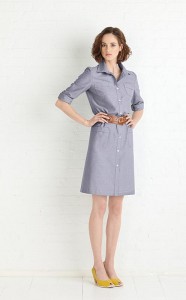
You can sew it as a tunic-length dress with a band collar that can be worn with leggings or skinny jeans (I refuse to call them “jeggings”!) or with tights and boots. You could try wearing this version open as a casual jacket, too. It would also look cute worn over a skirt that peeks out from underneath it, and with knee-hi socks and platform peep-toe heels.
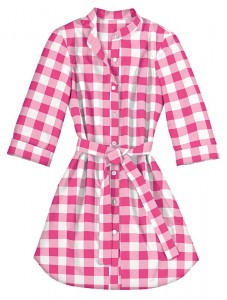
Finally, you can sew a dressier version with a gathered skirt and short sleeves. I like to wear this version with a skinny belt and heels to finish the look.
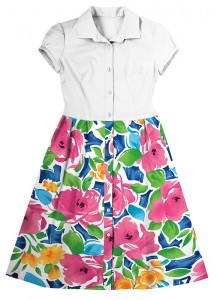
Which version is your style? Or will you make and wear all three? I know I have.
Over at Oliver + S, we had a best-selling pattern for girls last year called the Ice Cream Dress. I can’t tell you how many woman asked for this dress in their size.
I tried making it for myself, and although it was cute I knew we had a better option in the works for women: the Portfolio Dress!
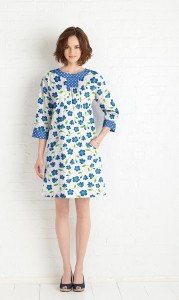 I’ll let you in on a secret. This dress is my favorite of all the Lisette styles for this season. It’s cute as a dress, as a tunic, and as a blouse. I like the three-quarter-length sleeves, and I also like the short sleeve options with the contrast yoke and cuffs and the gathered detail at the center front. I like that it doesn’t require zippers or buttonholes (there are two button loops at the back neck instead), the flattering cut, the casual styling. And my favorite part? The pockets.
I’ll let you in on a secret. This dress is my favorite of all the Lisette styles for this season. It’s cute as a dress, as a tunic, and as a blouse. I like the three-quarter-length sleeves, and I also like the short sleeve options with the contrast yoke and cuffs and the gathered detail at the center front. I like that it doesn’t require zippers or buttonholes (there are two button loops at the back neck instead), the flattering cut, the casual styling. And my favorite part? The pockets.
You can use two contrasting or coordinating fabrics, like we did here, or just one fabric. I’ve been wearing the dress version in a chambray linen and the tunic version in a beautiful Japanese double gauze that I bought at Alewives Fabrics in Nobleboro, Maine, when I was there teaching a workshop last fall. This is an easy summer piece that can double as a swimsuit cover-up, but it’s equally cute with heels for an evening out.
The pattern also includes a cropped, slim-fitting pant that looks great under the tunic or with the blouse. The pants have little buttons tabs at the hips for a nautical feel, and you can easily leave them off for a clean, sleek look.
If you see me this summer, chances are good that I’ll be wearing something I made from this pattern.
One thing I wanted to do with Lisette was to give you lots of options in every pattern envelope so that you can customize the final garment to your own personal style. I think we’ve done that well with the Market Dress, Tunic, Skirt, & Blouse sewing pattern.
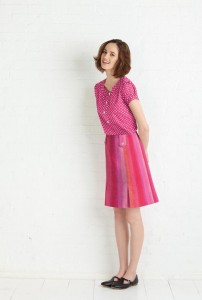 The Market top is an simple style that can be made as a blouse, tunic, or dress. While the blouse (shown at right) is very cute, I actually like the tunic length best. (We’ll have some photos of this view to share shortly.) I think it would make a great summer top or swimsuit cover-up if made in linen or printed cotton. But it can also look dressy made up in silk. It pulls on over the head with no closures, so it’s easy and quick to make. But it has a great fit, with high armholes and a narrower sleeve at the bicep that is very flattering without being restricting (or constricting, either). You can make it in two fabrics to emphasize the details, or use one fabric for a completely different look. While the buttons are optional (the placket is decorative only), you can have fun with them as a design element. The three-quarter length sleeve (my favorite) has a cute ruffle at the elbow, and the short sleeve is sweet and feminine.
The Market top is an simple style that can be made as a blouse, tunic, or dress. While the blouse (shown at right) is very cute, I actually like the tunic length best. (We’ll have some photos of this view to share shortly.) I think it would make a great summer top or swimsuit cover-up if made in linen or printed cotton. But it can also look dressy made up in silk. It pulls on over the head with no closures, so it’s easy and quick to make. But it has a great fit, with high armholes and a narrower sleeve at the bicep that is very flattering without being restricting (or constricting, either). You can make it in two fabrics to emphasize the details, or use one fabric for a completely different look. While the buttons are optional (the placket is decorative only), you can have fun with them as a design element. The three-quarter length sleeve (my favorite) has a cute ruffle at the elbow, and the short sleeve is sweet and feminine.
The skirt can be made in two lengths. The longer skirt includes cute little kick pleats at the front and back while the shorter skirt eliminates the kick pleats and focuses on the piecing. I like the seaming details because you can add contrast topstitching for a professional, sporty look. Both skirts have decorative button tabs that could also be used as belt loops. The A-line cut is flattering on pretty much everyone. The skirt has a side zip, and the waistband uses twill tape instead of a facing. It’s very easy to sew and helps the waistband keep its shape but isn’t visible and doesn’t add any bulk at the waistline.
We paired the skirt and blouse with flats for the photo shoot, but you can imagine how nice the skirt would look with wedges or with some serious heels, too. Pick your top length, pick your skirt length, pick your heels. It’s all about your style.
Everyone needs a great little jacket. Something that can go to a business meeting just as easily as it can go to dinner. Or to the playground.
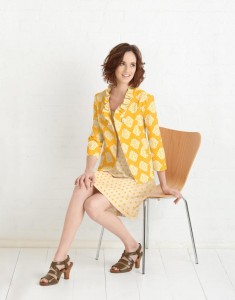 It would be nice if that jacket was fairly easy to make. Not a big time commitment or terribly complicated. No lining so it can be layered easily and can go into the washing machine as needed. And maybe a couple of different collar options to keep things interesting: a band collar and a sweet (but not too sweet) ruffle. A flattering fit: not too boxy but not too fitted. And just the right length so it looks great over a dress, skirt, trousers, or jeans.
It would be nice if that jacket was fairly easy to make. Not a big time commitment or terribly complicated. No lining so it can be layered easily and can go into the washing machine as needed. And maybe a couple of different collar options to keep things interesting: a band collar and a sweet (but not too sweet) ruffle. A flattering fit: not too boxy but not too fitted. And just the right length so it looks great over a dress, skirt, trousers, or jeans.
OK, now how about a nice, simple dress to go with it? Not a boring dress. Let’s keep it interesting with some diagonal darts at the center front, a gently pleated not-too-full skirt, and a scooped neckline that will show off a beautiful necklace. This dress can be fitted beautifully thanks to a side zipper. (You’ll be surprised. That zipper isn’t as difficult to sew as you might have imagined!) It’s a great summer dress and could also be made in dressy fabrics for special occasions.
We’ve given you all these things in our new Passport Dress and Jacket sewing pattern. Pick your design options, select your fabric, and use it to sew something that fits your personal style.
← Older posts Newer posts →
 We’ve been excited to hear your reaction to seeing them in your local stores, and we hope to hear from more of you as they make their way into the remaining Jo-Ann stores across the country.
We’ve been excited to hear your reaction to seeing them in your local stores, and we hope to hear from more of you as they make their way into the remaining Jo-Ann stores across the country.